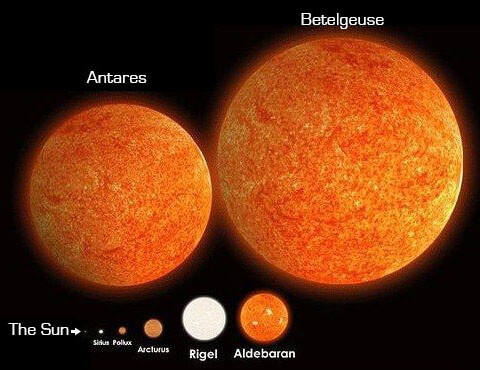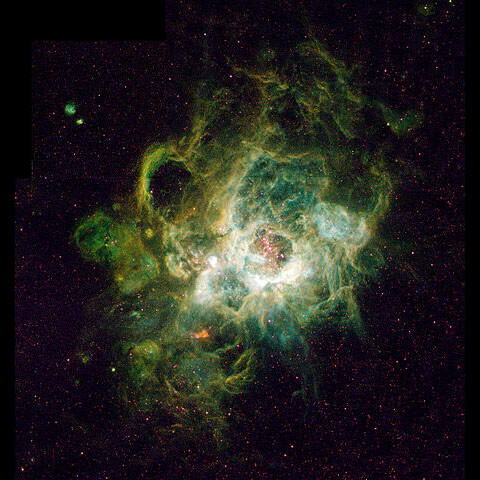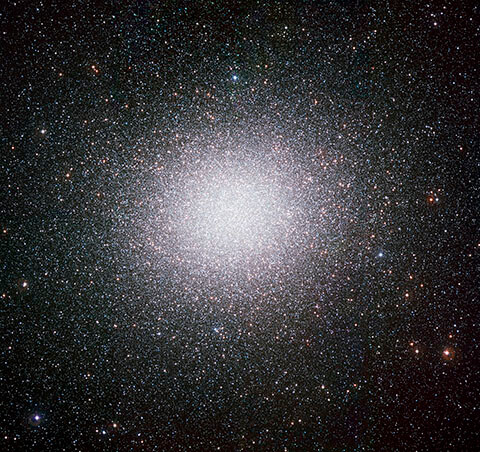Sizes of Things in Space
This page lists all the common types of celestial object with their typical sizes, along with some explanations and comparisons. Measurements are shown in metric. Hover or tap/click any of the metric values to see the imperial conversion.
Before we start, it's worth mentioning that things in space are much bigger and much farther apart than most people think. It's difficult to describe astronomical sizes because the numbers are so large. Can you imagine something that is 130x1014 metres wide? Measurements like these are important to astronomers but they don't help much when it comes to visualizing the Universe because the human brain can't form an image of them.
Therefore, as well as giving the measured size of an object, we often use comparisons with scales that we're more familiar with. For example:
- If the Earth was the size of a basketball, the Moon would be the size of a tennis ball.
- Traveling at 100 km/hour it would take more than five months to get from the Earth to the Moon.
Now, on to the list...
Objects in Our Solar System

The image above shows the Sun and eight major planets in our Solar System. They are all the correct size ratio to each other but the distances are not to scale (we'll cover distances later). These are the biggest objects in the Solar System1 but there are many other things too. The list below is roughly ordered in size from smallest to biggest although there are numerous overlaps and complications when comparing sizes (nothing is ever straightforward in astronomy).
Micrometeoroids
These are tiny particles of rock floating around in space, usually weighing less than one gram. If a micrometeoroid hits the Earth's atmosphere, it's actually small enough to avoid burning up and will drift down to the surface.
Meteoroids
These are larger pieces of rock ranging in size from small grains to about one metre wide. They are the most common source of "shooting stars", technically called meteors. A meteor that survives all the way to the surface is called a meteorite.
Asteroids
Also known as minor planets or planetoids, asteroids can be up to 1,000 km wide. Most asteroids orbit the Sun in the Asteroid belt between Mars and Jupiter.
Moons
Moons, defined as natural satellites of planets, can range from a couple of kilometres to thousands of kilometres wide. The biggest moon in our Solar System is Jupiter's Ganymede at 5,268 km across.
Since moons always orbit planets, most moons are smaller than most planets. However two moons in our Solar System are larger than the planet Mercury (Ganymede and Titan), and seven moons are larger than the dwarf planet Pluto (Earth's Moon, Ganymede, Titan, Callisto, Io, Europa and Triton).
Planets
Mercury, the smallest planet in our Solar System, is about 5,000 km in diameter. Earth is relatively large for a rocky (solid) planet at 12,750 km.
The largest planet, Jupiter, is 140,000 km wide. It's so big that all the other planets in the Solar System could fit inside it. Earth could fit inside Jupiter 1,300 times.
The Sun
The Sun is a moderately-sized star with a diameter of about 1.4 million km. It is by far the most massive object in the Solar System, containing 99.8% of all the Solar System's mass. The Earth would fit inside the Sun 1.3 million times.
Comets
Comets are icy bodies that sometimes come from the outer Solar System to the inner region near to the Sun, sprouting tails as they heat up. The solid part of the comet, the nucleus, is usually less than 50 km across. However the gaseous coma can be as big as the Sun (1.5 million km wide) and the tail can be incredibly long at hundreds of millions of kilometres. Note that being this big doesn't make it correspondingly massive, because comet comas and tails are gaseous without much actual mass.
Objects Beyond the Solar System
Stars
The most common type of star in our galaxy is the red dwarf, which can be as small as 130,000 km diameter—less than 1/10 the size of our Sun and barely larger than Saturn.
The Sun has a diameter of 1,400,000 km. This makes it larger than average but that's just because there are so many red dwarfs bringing the average size down. The Sun is a runt compared to the really big stars. The image below shows the Sun as a tiny dot compared to some of the stars we can see in our night sky.

Antares (in the constellation Scorpius) and Betelgeuse (in Orion) are both red giant stars. You can see their redness when you look at them with the unaided eye. Betelgeuse is over a billion km wide—900 times the size of the Sun. If the Sun was the same size as Betelgeuse it would engulf the planets Mercury, Venus, Earth, Mars and possibly even Jupiter.
Betelgeuse is the biggest star you can easily see with the unaided eye but the largest known stars are somewhat larger. Because many of our measurements are estimates, we can't be sure which is the biggest star we've found. Contenders include UY Scuti at 2.4 billion km wide (1,700 times the size of the Sun) and Stephenson 2-18 (2,150 times the size of the Sun).
Black Holes
Black holes can be any size from microscopic to billions of kilometres wide. It's a bit tricky talking about the "size" of a black hole because everything in it gets crushed to a presumably infinitely small size. However we can measure the radius of the accretion disk (ring of surrounding matter falling in) and the event horizon (the point of no return when falling in). Astronomers have found black holes that have disks many times the size of our Solar System.

Black hole with accretion disk (CGI image by NASA)
Nebulae
A nebula is a giant cloud of dust and gas floating in space. There are different types of nebulae but they're all big, ranging from the size of our Solar System to hundreds of light-years across. Individual stars are tiny dots compared to nebulae.

Nebula NGC 604
Star Clusters
A star cluster is a group of stars that are connected by gravity (gravitationally bound). They can consist of hundreds, thousands or millions of stars. They are a bit like very small galaxies, in fact some could be the remnants of galaxies after some catastrophic event. Star clusters are typically 10 to 30 light-years across.
Galaxies
The smallest dwarf galaxies are around 200 light-years wide. Our galaxy (the Milky Way) is 100,000 light-years wide. The largest known galaxy is called IC 1101, 4 million light-years wide and containing a staggering 100 trillion stars.

Andromeda Galaxy (photo by NASA)
Galaxy Clusters and Superclusters
Galaxies are arranged in clusters that are typically several million light-years wide, which in turn may be part of larger superclusters that could be up to several billion light-years across. These are the largest structures in the known Universe.
Previous: The Structure of the Universe | Next: Distances in space

